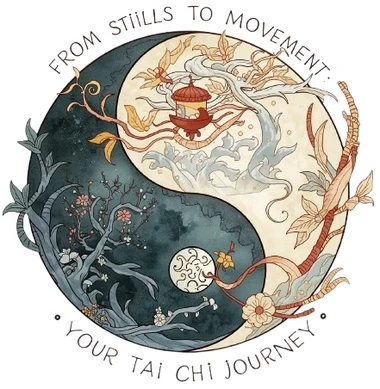You’ve seen the videos.
Someone moves slowly, arms floating like silk. They breathe. They smile. You think: That’s peace. That’s health. That’s me.
So you try Ba Duan Jin — Eight Pieces of Brocade. You copy the motions. You even do it every morning.
But after weeks… nothing changes.
No more energy. No deeper calm. Just… repetition.
Here’s the truth no YouTube tutorial will tell you:
Ba Duan Jin isn’t about moving your arms. It’s about not messing up the subtle things — the ones that make or break the whole practice.
And if you’re doing those wrong — even slightly — you’re not cultivating Qi. You’re wasting time.
I’ve watched hundreds of students. I’ve judged competitions. I’ve studied the official Chinese government manual — the one no one talks about outside of Beijing.
Let me tell you what they see. What they punish. And how you can fix it — without a single class. If you’re new to Ba Duan Jin, start with our simple guide to Ba Duan Jin.
The 10 Most Common Ba Duan Jin Mistakes — And How to Fix Them
Based on the official guidelines of China’s General Administration of Sport — and refined through years of teaching at Tai Chi Wuji.
| # | Mistake | What Most People Do | What You Should Do | Appears In | Competition Penalty | ✅ Tai Chi Wuji Correction (For Daily Practice) |
|---|---|---|---|---|---|---|
| 1 | Eight Trigram Palm (Ba Zi Zhang) is flat or convex | Palm pushes outward like stopping a car. Fingers stiff or splayed. | Thumb and index finger form a soft “V.” Other three fingers gently curved — like holding a ripe peach. Palm slightly hollowed. Fish muscles drawn inward. | All movements | 0.1 pts per error (max 0.4 for group) | Try this: Press your palm lightly against a wall. Feel the natural curve form as you relax your fingers. Let your palm feel like it’s cradling air — not pushing it away. |
| 2 | Dragon Claw (Long Zha) is loose or clenched | Fingers gap apart. Palm caves in. Or — worse — it’s a tight fist. | All five fingers together. Tips touch base of fingers. Palm curves outward like a gentle cup holding warmth. No tension. No gap. | “Drawing the Bow to Shoot the Eagle” | 0.1 pts per error | Imagine: "You’re holding a warm egg — firm enough not to drop it, soft enough not to crush it. That’s the Dragon Claw." |
| 3 | Natural Palm (Zi Ran Zhang) has curled pinky | Pinky finger bends inward. Wrist twists. Hand feels unnatural. | Fingers naturally spaced. Palm slightly concave. No forced separation. No hidden curl. | “Two Hands Hold Up the Heavens,” “Single Lift,” etc. | 0.1 pts per error | Try this: Place your palm flat on your forehead. Let your fingers fall naturally. Now lower your hand slowly — that’s your Natural Palm. Don’t adjust. Just release. |
| 4 | Feet turned out (pigeon-toed) | Toes point outward. Knees follow. Body leans. | Feet parallel. Toes point straight ahead. Weight evenly distributed. | All stances: open step, horse stance | 0.1 pts per error | Lay two strips of tape on the floor — shoulder-width apart. Stand on them. Just stand. Breathe. Feel your arches lift. This is your foundation. |
| 5 | Knees past toes (“kneeling”) in horse stance | Leaning forward. Knees collapse over toes. Pain in front of knee. | Knees stay aligned with ankles. Never extend beyond the toes. Hips sink back like sitting on a low stool. | “Drawing the Bow,” “Separate Wild Horse’s Mane” | 0.1 pts per error | Visualize: There’s a wall behind you. Push your hips back until your knees are directly over your ankles. Your spine stays long. |
| 6 | Buttocks sticking out (piking, arching lower back) | Lower back over-arched. Tailbone sticks up. Center lost. | Spine neutral. Tailbone gently tucked. Belly soft. Weight centered over feet. | Horse stance, all grounded movements | 0.1 pts per error | Place hands on your hip bones. As you squat, feel them move slightly backward — not down. This keeps your spine long and your center grounded. |
| 7 | Turning head AND shoulders together | Whole upper body twists when looking back. Shoulders lead. | Only the head turns. Shoulders, chest, hips — remain still. Eyes follow the gaze. | “Looking Backward to Cure the Five Labors and Seven Injuries” | Clear form error — always penalized | Place your hands on your shoulders. Now turn your head — without moving your hands. If your hands stay still? You’re doing it right. |
| 8 | Shoulders rise or push forward on punch | Shoulder jolts forward as fist extends. Power comes from arm, not body. | Fist drives from waist. Shoulder stays relaxed and down. Power flows from feet → legs → waist → arm → fist. | “Clench the Fists and Glare Fiercely” | Disrupts energy flow — form error | Practice this: Stand with fists at your waist. Exhale sharply — and snap your fist forward. Feel your waist turn first. Your arm is just the messenger. |
| 9 | Hips sway during waist turn | When turning, hips follow. Body wobbles. Root lost. | Waist turns. Hips stay fixed. Lower body is still. Upper body moves like a spinning top on a stable base. | All turning movements | Compromises stability — body alignment error | Place hands on your hips. As you turn, feel your hip bones stay level. If they move? You’re not turning from the waist — you’re just swinging. |
| 10 | Timing of palm flip is off | Palm turns too early or too late — disconnected from breath and movement. | Flip happens with the upward lift — synchronized with inhalation. Return with exhalation. | “Two Hands Hold Up the Heavens” | Breaks rhythm — affects Qi flow | Break it down: Rise → pause → flip → push up. Do it slowly. Feel the breath. The movement is not mechanical — it’s poetic. Let it flow with your breath. |
Tai Chi Wuji Wisdom: The Real Practice Isn’t in the Movements — It’s in the Return
You don’t need to do all eight pieces perfectly.
You just need to notice when you’re not.
One breath. One hand. One step.
That’s where healing begins.
At Tai Chi Wuji, we don’t teach you to mimic.
We teach you to return.
To stillness.
To alignment.
To presence.
This table isn’t a checklist of “don’ts.”
It’s a mirror.
Every time you catch yourself curling your pinky —
you’re waking up.
Every time you stop your knee from drifting —
you’re choosing balance.
Every time you turn your head without moving your shoulder —
you’re practicing focus in a distracted world.
That’s not just Qigong.
That’s Wuji.
“The most powerful movement is the one you do with your whole self — not just your arms, not just your legs… but your stillness.” — Tai Chi Wuji
Let this table live on your fridge.
On your phone.
Next to your mat.
Practice one correction per day.
Just one.
And watch how slowly, quietly —
everything changes.
You don’t need to be perfect.
You just need to be present.
That’s the Wuji way.
And that’s why you practice.

Your Hands Are Talking. Are They Saying the Right Thing?
Most people think: “I just need to raise my arms.”
Wrong.
Your hands? They’re your Qi antennas. And if they’re shaped wrong, you’re broadcasting static.
There are three hand forms in Ba Duan Jin. Get one wrong, and you drain energy. Get two wrong? You’re basically doing a different exercise.
Let’s break it down — simply.
The Eight Trigram Palm (Ba Zi Zhang)
You want your thumb and index finger straight. The other three? Gently curled — like holding a small apple.
- What most people do: They flatten their palm. Or worse — push it out like they’re stopping a bus.
- Result? Qi gets blocked. Your wrist tightens. Your shoulder shrugs.
- Fix it: Stand in front of a mirror. Press your palm flat against the glass. Now, slowly curl your ring and pinky fingers inward — just enough to make a soft, natural hollow in your palm. That’s it. That’s the shape.
The Dragon Claw (Long Zha)
Think “claw,” not “fist.” All fingers together. Fingertips touch the base of your fingers. Palm curves outward — like you’re cradling a warm egg.
- What most people do: They let fingers gap. Or they squeeze too hard. Or — and this is common — they let the palm cave in.
- Result? You lose the “grasp” of intention. The energy doesn’t flow forward.
- Fix it: Try this: Make a loose fist. Now, slide your thumb and index finger open — keeping the other three pressed together. Feel that tension? That’s the Dragon Claw. Not tight. Not loose. Just present.
The Natural Palm (Zi Ran Zhang)
This one looks easy. Five fingers apart. Palm slightly concave.
- What most people do: They let their pinky finger curl under. Like they’re holding a phone.
- Result? Your entire forearm twists. Your shoulder compensates. Your breath gets shallow.
- Fix it: Place your palm flat on your forehead. Let your fingers fall naturally. Now, lower your hand slowly. That’s your Natural Palm. No forcing. No curling. Just release.
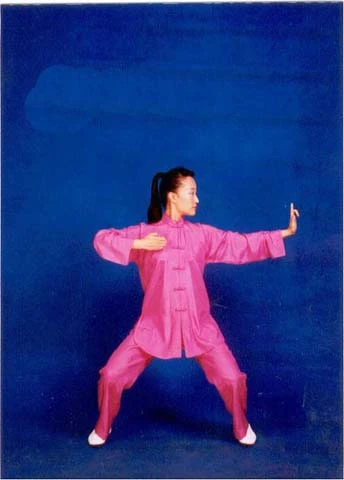
Your Feet Are the Root. Are They Grounded — or Twisted?
You don’t need to be a martial artist to know this: if your feet are off, everything else is off.
The official rules are clear: Toes point forward. Always.
That’s it.
But here’s what I see every week:
Feet turned out. Like a penguin.
Knees collapsing inward during Horse Stance.
Buttocks sticking out like a duck’s tail.
All of these? They’re not “just a little off.” They’re injuries waiting to happen.
- Toes Out? → Strains your knees. Rotates your hips. Kills your balance.
Fix: Tape two lines on your floor — parallel, shoulder-width apart. Stand on them. Every morning. For 30 seconds. Just stand. Feel your feet root. - Knees Over Toes? → You’re not deepening your stance. You’re crushing your patellar tendon.
Fix: When you sink into Horse Stance, imagine a wall behind you. Push your hips back — like you’re sitting into a chair. Your knees stay behind your toes. Always. - Poking Buttocks? → You’re arching your lower back. You’re not centered. You’re leaning.
Fix: Place your hands on your hip bones. As you squat, gently tuck your tailbone down — not hard. Just enough to feel your spine lengthen. Like a cat stretching.

The Three Movements That Break Everyone (And How to Fix Them)
Here’s where most people think they’re doing it right — and they’re not.
It’s not about speed. It’s about where the movement starts.
“Drawing the Bow to Shoot the Eagle”
You swing your arms out — and your shoulders roll forward.
Wrong.
The arms move. The shoulders? Stay still. The turn? Comes from your waist — not your chest.
Try this: Put your hands on your shoulders. Now, extend your arms — without letting your shoulders move. Feel the twist in your waist? That’s the movement. That’s the Qi.
“Looking Backward to Cure the Five Labors and Seven Injuries”
You turn your head — and your whole upper body twists.
Wrong.
Your neck rotates. Your spine? Still. Your hips? Locked.
Try this: Place a book on your head. Turn your eyes — not your shoulders. If the book stays put? You’re doing it right.
“Clench the Fists and Glare Fiercely”
You punch — and your shoulder jolts forward.
Wrong.
Power doesn’t come from the arm. It comes from the waist. The fist? It’s the finish.
Try this: Stand with your fists at your waist. Now, exhale sharply — and snap your fist forward. Feel your waist turn first? That’s the secret. Your arm is just the messenger.
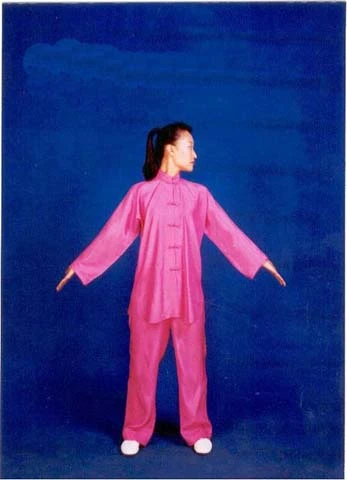
The Real Secret of Ba Duan Jin? It’s Not in the Movements — It’s in the Stillness
You don’t need to do all eight pieces perfectly.
You need to do one piece — with perfect attention.
That’s the Wuji way.
At Tai Chi Wuji, we don’t teach you to mimic. We teach you to notice.
The pause between breaths.
The weight shift in your foot.
The quiet tension in your palm.
That’s where the healing lives.
Stop chasing the form.
Start feeling the space inside the form.
Practice one hand shape. One stance. One breath — every day.
For 7 minutes.
Not 20.
Not 40.
That’s enough.
Because Ba Duan Jin isn’t about doing more.
It’s about being more present.
And that? That changes everything.
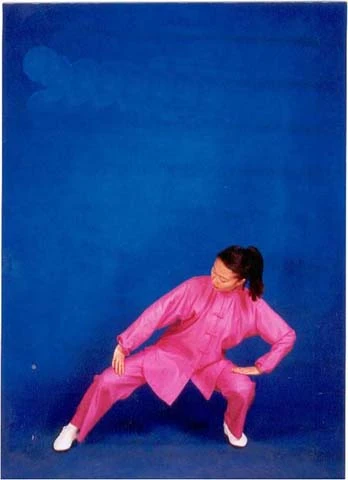
Your Next Step — Simple. No Apps. No Courses. Just You.
Pick one error from above.
Stand in Wuji stance for 3 minutes. Breathe. Feel your feet.
Do one movement — slowly — focusing only on that one thing.
Record yourself on your phone. Watch it.
Repeat tomorrow.
No perfection needed.
Just presence.
That’s the Wuji path.
And it’s the only one that lasts.

Your Practice, Your Sanctuary
You’ve probably heard it before: “Tai Chi is meditation in motion.”
But what if I told you Ba Duan Jin is meditation before motion?
It’s not a warm-up. It’s not a filler. It’s the quiet foundation — the breath before the wave.
At Tai Chi Wuji, we see Ba Duan Jin as the bridge between Wuji and Taiji.
The stillness you hold in Zhan Zhuang…
The calm you find in your breath…
The groundedness you build in your feet…
That’s the same energy you carry into each palm, each turn, each shift.
When you fix your Dragon Claw, you’re not just correcting a hand shape.
You’re learning to hold intention — without tension.
When you stop letting your knees cave, you’re not just protecting your joints.
You’re learning to stand — truly stand — in your own power.
When you turn your head without moving your shoulders, you’re not just following a rule.
You’re practicing focus — the kind that doesn’t scatter.
This isn’t gymnastics.
This is inner architecture.
And you don’t need a competition to prove it.
You just need to show up.
Every morning.
With one question:
“Am I here — or just going through the motions?”

What We Teach at Tai Chi Wuji — And What We Don’t
We don’t teach you to “get it right.”
We teach you to feel it right.
You won’t find us pushing you to do 100 reps.
You won’t find us grading your form like a judge.
You won’t find us saying, “That’s wrong.”
Instead, we ask:
Where did you feel the energy stop?
What part of your body felt tight — and why?
Could you have moved just a little slower… and deeper?
We’ve watched students cry the first time they held a Natural Palm correctly — not because it was hard, but because for the first time, they felt their hand… truly.
That’s the magic.
Not in perfection.
In presence.
We teach Ba Duan Jin as part of the larger Wuji journey — not as a standalone exercise, but as a daily return to center.
It’s the quiet companion to your Zhan Zhuang.
It’s the gentle echo of your Tai Chi form.
It’s the breath you carry into your day.
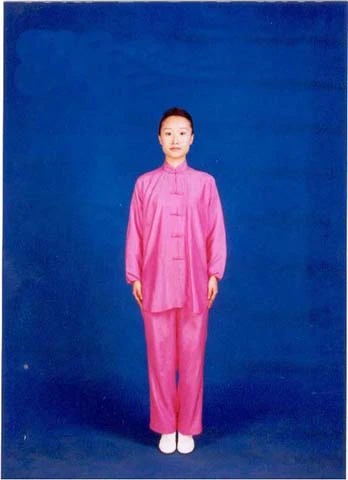
Start Here — Right Now
You don’t need to wait.
You don’t need to sign up.
You don’t need to buy anything.
Here’s your invitation — today:
Stand.
Breathe.
Place your hands in Natural Palm — flat against your belly.
Feel the slight hollow.
Let your fingers fall naturally.
Don’t force. Don’t fix. Just be.
Hold it for 3 breaths.
Now — gently lift them, palms up, as if receiving morning light.
Feel the softness in your wrists.
Now — lower them.
That’s it.
That’s Ba Duan Jin.
That’s Wuji.
That’s enough.
Ba Duan Jin Is Your Daily Return to Stillness
You don’t need to master all eight pieces.
You just need to return — again and again — to the truth beneath them.
That your hands are more than limbs.
That your feet are more than supports.
That your breath is more than air.
That stillness isn’t empty.
It’s full.
And it’s waiting — right here, right now — in the quiet space between your next breath.
At Tai Chi Wuji, we believe the deepest healing doesn’t come from complicated forms.
It comes from simple, honest return.
So tomorrow morning — before the coffee, before the phone, before the noise —
Stand.
Breathe.
Move — with care.
And remember:
The most powerful movement is the one you do with your whole self.
Not just your arms.
Not just your legs.
But your stillness.
Your presence.
Your Wuji.
That’s where the real brocade begins.
This Isn’t Just Exercise — It’s an Act of Reclamation
Let’s be real.
We live in a world that rewards speed.
More. Faster. Better. Now.
We scroll. We multitask. We optimize.
And we’ve forgotten how to just… be.
Ba Duan Jin doesn’t ask you to be better.
It asks you to be here.
When you correct your Eight Trigram Palm — not because a judge said so, but because you feel the energy rise through your arm — you’re not practicing a form.
You’re reclaiming your body from autopilot.
When you stop letting your knees cave in Horse Stance — not to avoid a point deduction, but because you finally feel your weight sink into the earth — you’re not doing a squat.
You’re rebuilding your connection to the ground.
At Tai Chi Wuji, we call this returning to source.
It’s not about becoming a better practitioner.
It’s about becoming a better person.
One quiet, correct breath at a time.
The Wuji Lens — Why We Teach It This Way
You won’t find us saying, “Do it this way because the manual says so.”
We say: “Feel where the energy stops.”
Because here’s what the official judging manual doesn’t tell you:
The errors aren’t just technical — they’re emotional.
That curled pinky in your Natural Palm?
That’s your nervous system holding on — to stress, to control, to the past.
That shoulder rolling forward during “Drawing the Bow”?
That’s your body trying to protect itself — from pressure, from expectation, from feeling vulnerable.
That knee drifting past your toes?
That’s your foundation giving way — just like your patience, your focus, your peace, when life gets loud.
We teach Ba Duan Jin not as a set of movements to memorize.
We teach it as a mirror.
Every time you fix a hand shape — you’re learning to hold yourself with gentler precision.
Every time you root your feet — you’re choosing to stand in your own power.
Every time you turn your head without moving your shoulders — you’re practicing the most radical act of focus in a distracted world.
That’s the Wuji difference.
We don’t just show you how to move.
We show you how to stop running.
Your Practice Is Your Sanctuary — Even If It’s Just 5 Minutes
You don’t need a studio.
You don’t need silence.
You don’t need to be “good.”
You just need to show up — even for five minutes.
Here’s how to begin — today — with zero pressure:
Stand in Wuji. Barefoot if you can. Feet parallel. Shoulders soft. Eyes gently lowered. Breathe into your belly. Just stand. For 90 seconds. Let your thoughts come. Let them go.
Shape your hands. Not to look right. But to feel right. Make the Dragon Claw. Feel the energy in your palm. Don’t force it. Just notice.
Do one movement. Pick one — say, “Two Hands Hold Up the Heavens.” Do it once. Slowly. With full attention. Feel your breath rise as your hands rise. Feel your weight settle as you lower.
Pause. Before you move on with your day — pause. Just for one breath. Ask: Where did I feel alive?
That’s it.
That’s all.
Five minutes.
No apps. No goals. No performance.
Just presence.
This is what we teach at Tai Chi Wuji.
Not because it’s easy.
But because it’s true.
The Real Mastery Is in the Quiet Correction
You think mastery means doing all eight pieces perfectly?
No.
Mastery means catching yourself — again — when your pinky curls.
Mastery means noticing, without judgment, that your knee drifted forward — and gently bringing it back.
Mastery means returning — again and again — to the stillness beneath the movement.
That’s not perfection.
That’s practice.
And it’s the only thing that lasts.
At Tai Chi Wuji, we don’t measure progress by how many times you’ve done Ba Duan Jin.
We measure it by how many times you’ve returned to yourself.
You don’t need to compete.
You don’t need to impress.
You just need to show up — with your hands, your feet, your breath — and say:
I’m here.
And that? That’s the most powerful form of Qi Gong there is.
Your Invitation — Not to Perfect, But to Return
So tomorrow morning — before the world wakes up —
Stand.
Breathe.
Let your hands rest — not as tools, but as teachers.
Let your feet ground — not as support, but as home.
Let your body move — not to fix, but to feel.
You don’t need to be perfect.
You just need to be present.
That’s the Wuji way.
That’s the Ba Duan Jin way.
And that — right there — is where true healing begins.
Ba Duan Jin is your daily return to stillness.
Frequently Asked Questions
Why is my Ba Duan Jin practice not giving me results?
ou might be focusing on completing the movements instead of feeling them. Small errors—like a curled pinky or turned-out toes—disrupt energy flow and reduce effectiveness. Precision isn’t about perfection; it’s about presence. Fix one detail at a time, and you’ll start to feel the difference.
Do I need to be flexible or athletic to do Ba Duan Jin correctly?
No. Ba Duan Jin is designed for all body types and fitness levels. What matters most is alignment, breath, and mindful attention—not flexibility. At Tai Chi Wuji, we teach you to work with your body, not against it.
How long should I practice Ba Duan Jin each day?
Even 5–7 minutes of focused practice can make a lasting impact. Consistency beats duration. Start with one movement. Do it slowly. Feel it fully. That’s where transformation begins.
Is Ba Duan Jin the same as Tai Chi?
They’re close relatives. Both are rooted in Chinese philosophy and cultivate Qi through slow, intentional movement. But Ba Duan Jin is simpler—eight short forms focused on health and energy regulation—while Tai Chi includes longer sequences with martial applications. Many people practice both.
Can correcting small details really change my experience?
Absolutely. Think of it like tuning an instrument. A slightly loose string doesn’t ruin the song—but it dulls the resonance. When your hand shape is right, your breath matches your motion, and your stance is grounded, the whole practice comes alive.
What’s the connection between Wuji and Ba Duan Jin?
Wuji is stillness—the quiet center before movement arises. Ba Duan Jin begins and ends there. At Tai Chi Wuji, we see this practice not just as exercise, but as a daily return to that inner stillness. Every corrected posture is a step back to balance.
Where can I learn Ba Duan Jin with proper guidance?
We offer free foundational resources and structured video teachings at TaichiWuji.com . Whether you're new or experienced, our Qi Gong Arts curriculum helps you build authentic practice with clarity and care. You can also use our Find Your Teacher tool to connect with certified instructors worldwide.
Does Tai Chi Wuji follow official Chinese qigong standards?
Yes. Our teachings align with the principles from the General Administration of Sport of China’s Fitness Qigong Management Center. We respect tradition while making it accessible for modern life—because true wellness honors both depth and simplicity.
